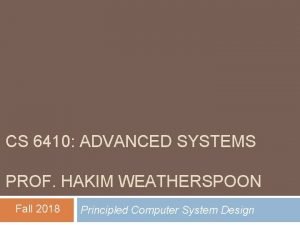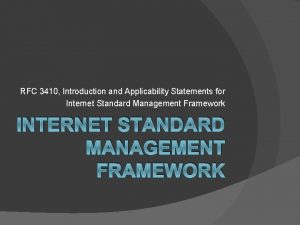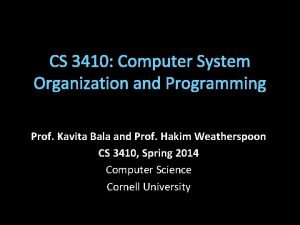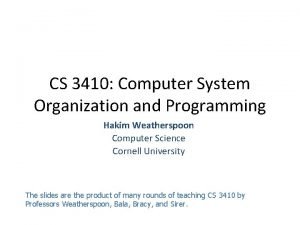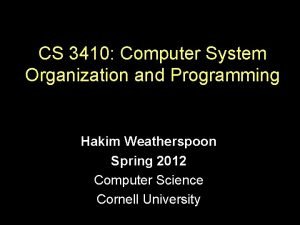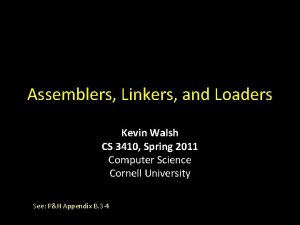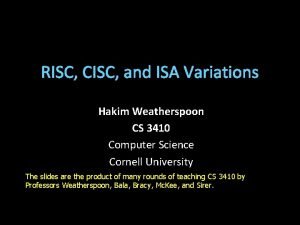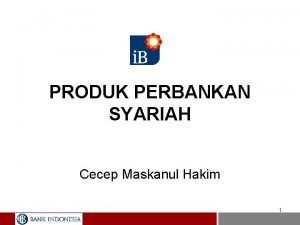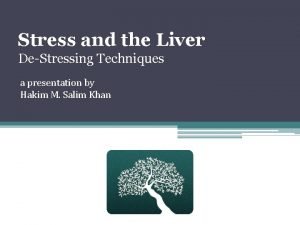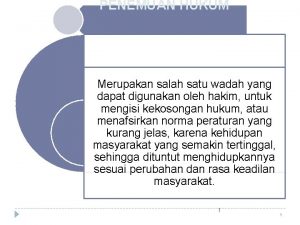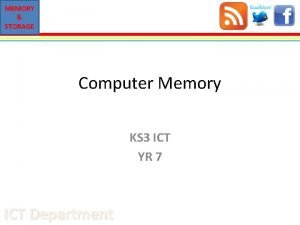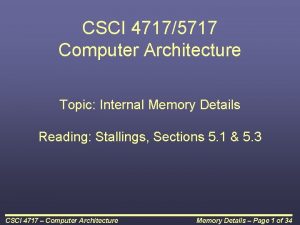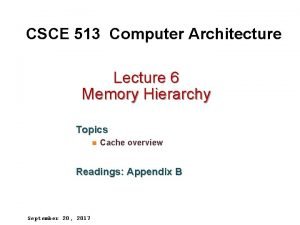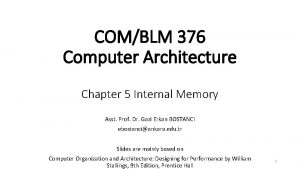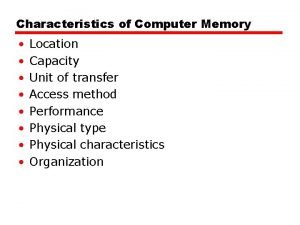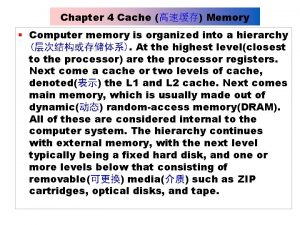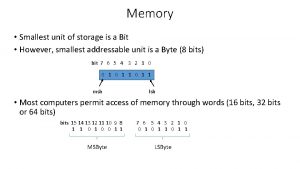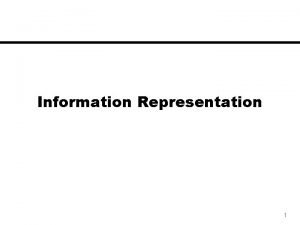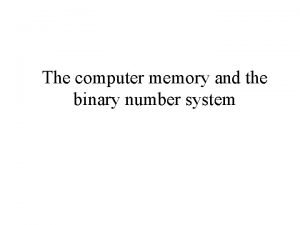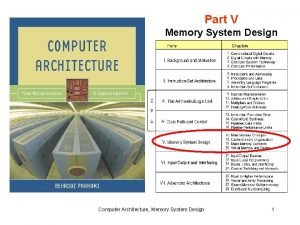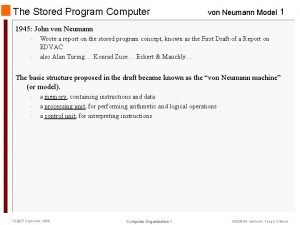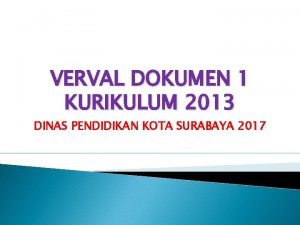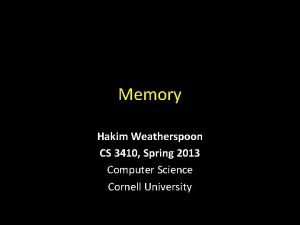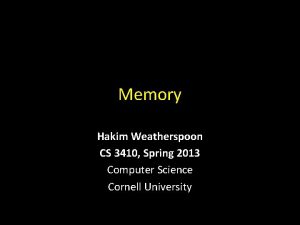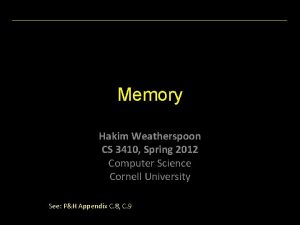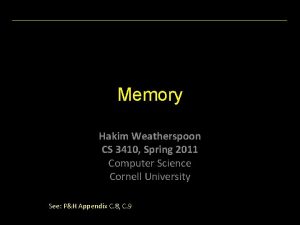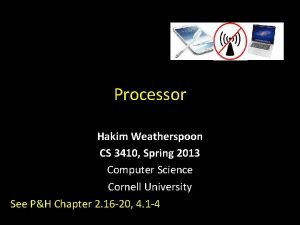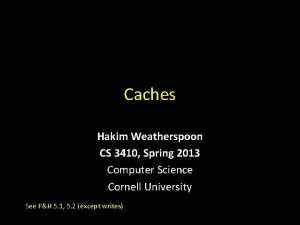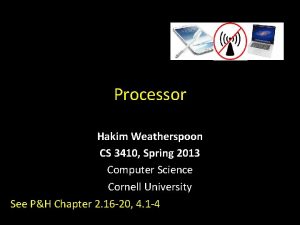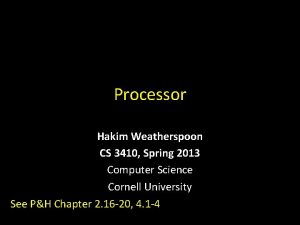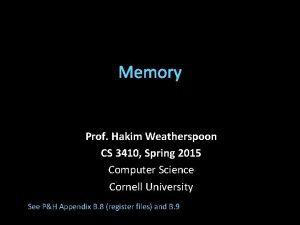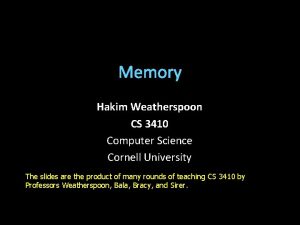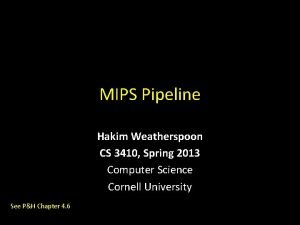Memory Hakim Weatherspoon CS 3410 Spring 2013 Computer



















































![SRAM Din[1] E. g. How do we design a 4 x 2 SRAM Module? SRAM Din[1] E. g. How do we design a 4 x 2 SRAM Module?](https://slidetodoc.com/presentation_image_h2/6e2894c6b22b6fe3d9645b079869da55/image-52.jpg)
![SRAM Din[1] E. g. How do we design a 4 x 2 SRAM Module? SRAM Din[1] E. g. How do we design a 4 x 2 SRAM Module?](https://slidetodoc.com/presentation_image_h2/6e2894c6b22b6fe3d9645b079869da55/image-53.jpg)
![SRAM E. g. How do we design a 4 x 2 SRAM Module? Din[1] SRAM E. g. How do we design a 4 x 2 SRAM Module? Din[1]](https://slidetodoc.com/presentation_image_h2/6e2894c6b22b6fe3d9645b079869da55/image-54.jpg)



![SRAM E. g. How do we design a 4 x 2 SRAM Module? Din[1] SRAM E. g. How do we design a 4 x 2 SRAM Module? Din[1]](https://slidetodoc.com/presentation_image_h2/6e2894c6b22b6fe3d9645b079869da55/image-58.jpg)
![SRAM Din[1] E. g. How do we design a 4 x 2 SRAM Module? SRAM Din[1] E. g. How do we design a 4 x 2 SRAM Module?](https://slidetodoc.com/presentation_image_h2/6e2894c6b22b6fe3d9645b079869da55/image-59.jpg)












- Slides: 71

Memory Hakim Weatherspoon CS 3410, Spring 2013 Computer Science Cornell University

Big Picture: Building a Processor memory inst +4 register file +4 =? PC control offset new pc alu target imm cmp extend A Single cycle processor addr din dout memory

Goals for today Review • Finite State Machines Memory • • Register Files Tri-state devices SRAM (Static RAM—random access memory) DRAM (Dynamic RAM)

Which statement(s) is true (A) In a Moore Machine output depends on both current state and input (B) In a Mealy Machine output depends on current state and input (C) In a Mealy Machine output depends on next state and input (D) All the above are true (E) None are true

Mealy Machine Registers General Case: Mealy Machine Current State Input Comb. Logic Output Next State Outputs and next state depend on both current state and input

Moore Machine Registers Special Case: Moore Machine Current State Comb. Logic Output Input Comb. Logic Next State Outputs depend only on current state

Example #2: Digital Door Lock Inputs: • keycodes from keypad • clock Outputs: • “unlock” signal • display how many keys pressed so far

Door Lock: Inputs Assumptions: • signals are synchronized to clock • Password is B-A-B K A B K 0 1 1 A 0 1 0 B 0 0 1 Meaning Ø (no key) ‘A’ pressed ‘B’ pressed

Door Lock: Outputs Assumptions: • High pulse on U unlocks door D 3 D 2 D 1 D 0 4 LED 8 dec U Strategy: (1) Draw a state diagram (e. g. Moore Machine) (2) Write output and next-state tables (3) Encode states, inputs, and outputs as bits (4) Determine logic equations for next state and outputs

Door Lock: Simplified State Diagram Ø Ø G 1 ” 1” “A” “B” G 2 ” 2” else “B” else G 3 ” 3”, U any Idle ” 0” Ø else any B 1 ” 1” else B 2 ” 2” Ø else B 3 ” 3” Ø (1) Draw a state diagram (e. g. Moore Machine)

Door Lock: Simplified State Diagram Ø Ø G 1 ” 1” else “B” Idle ” 0” Ø “A” G 2 ” 2” else “B” G 3 ” 3”, U any else B 1 ” 1” else B 2 ” 2” Ø Ø (1) Draw a state diagram (e. g. Moore Machine)

Door Lock: Simplified State Diagram Ø Ø G 1 ” 1” else “B” Idle ” 0” Ø “A” G 2 ” 2” else “B” Cur. any Output State else B 1 ” 1” else B 2 ” 2” Ø G 3 ” 3”, U Ø (2) Write output and next-state tables

Door Lock: Simplified State Diagram Ø Ø G 1 ” 1” else “B” Idle ” 0” Ø “A” G 2 ” 2” else B 1 ” 1” else B 2 ” 2” Ø Ø “B” G 3 ” 3”, U Cur. any Output State Idle “ 0” G 1 “ 1” G 2 “ 2” G 3 “ 3”, U B 1 “ 1” B 2 “ 2” (2) Write output and next-state tables

Door Lock: Simplified State Diagram Ø Ø G 1 ” 1” “A” else “B” Idle ” 0” Ø Cur. State G 2 ” 2” “B” else B 1 ” 1” else B 2 ” 2” Ø Ø (2) Write output and next-state tables Input Next State G 3 ” 3”, U any

Door Lock: Simplified State Diagram Ø G 1 ” 1” else “B” Idle ” 0” Ø “A” else B 1 ” 1” else Cur. State Ø Idle G 2 Idle “B” ” 2”Idle else. G 1 G 1 G 2 G 2 G 3 B 2 B 1 ” 2” B 1 B 2 Ø (2) Write output and next-state tables Input Next State Ø Idle “B”G 3 G 1 ” 3”, U “A” B 1 Ø any G 1 “A” G 2 “B” B 2 Ø B 2 “B” G 3 “A” Idle any Idle Ø B 1 K B 2 Ø B 2 K Idle

State Table Encoding SCur. SState S 0 D 3 2 1 0 Idle 0 0 G 1 0 0 G 2 1 0 0 0 G 3 1 1 0 1 B 1 0 0 0 1 B 2 0 1 0 DOutput 2 D 1 D 0 0 “ 0” 0 0 0 “ 1” 0 1 0 “ 2” 1 0 0“ 3”, 1 U 1 0 “ 1” 0 1 0 “ 2” 1 0 U 0 0 0 1 0 0 State S 2 S 1 8 S 0 4 Meaning K A B D 3 D 2 D 1 D 0 dec Idle 0 0 Ø (no 0 key) 0 U 0 0 1 G 1 1 1 0 ‘A’ pressed K 0 G 2 0 1 1 0 1 ‘B’ pressed A 1 B Cur. S 2 SState 1 S 0 0 Idle 0 0 0 G 1 0 1 0 G 2 1 0 0 G 3 1 1 1 B 1 0 0 1 B 2 0 1 K Input A B 0 Ø 0 0 1 “B” 0 1 1 “A” 1 0 0 Ø 0 0 1 “A” 1 0 1 “B” 0 1 0 Ø 0 0 1 “B” 0 1 1 “A” 1 0 x any x x 0 Ø 0 0 1 K x x G 3 0 1 B 1 1 0 0 (3) Encode states, and outputs as bits B 2 1 0 inputs, 1 Next S’ 2 S’State 1 S’ 0 0 Idle 0 0 0 G 1 0 1 1 B 1 0 0 0 G 1 0 G 2 1 0 1 B 2 0 1 0 B 2 1 0 0 G 3 1 1 0 Idle 0 0 1 B 1 0 0 1 B 2 0 1 0 Idle 0 0

3 bit Reg S 2 -0 D 3 -0 U 4 dec Door Lock: Implementation clk S 2 -0 K A B S’ 2 -0 S 2 0 0 1 1 S 1 0 0 1 1 0 0 S 0 D 3 0 0 1 0 D 2 0 0 0 D 1 0 0 1 1 0 1 D 0 0 1 1 0 (4) Determine logic equations for next state and outputs U 0 0 0 1 0 0

Door Lock: Implementation 3 bit Reg clk S 2 -0 K A B K 0 1 1 x 0 1 dec S 2 -0 S 2 S 1 S 0 4 D 03 -00 0 0 U 0 0 0 1 0 S’ 2 -0 1 0 0 1 1 1 0 0 1 0 1 A 0 0 1 0 0 0 1 x 0 x B 0 1 0 0 0 1 0 x 0 x S’ 2 S’ 1 S’ 0 0 0 1 1 0 0 1 0 1 0 1 0 0 1 1 0 0 0

3 bit Reg S 2 -0 D 3 -0 U 4 dec Door Lock: Implementation clk S 2 -0 K A S’ 2 -0 B Strategy: (1) Draw a state diagram (e. g. Moore Machine) (2) Write output and next-state tables (3) Encode states, inputs, and outputs as bits (4) Determine logic equations for next state and outputs

Administrivia Make sure to go to your Lab Section this week • • • Find project partners this week (for upcoming project 1 next week) Lab 2 due in class this week (it is not homework) Design Doc for Lab 1 due yesterday, Monday, Feb 4 th Completed Lab 1 due next week, Monday, Feb 11 th Work alone Homework 1 is due Wednesday • Work alone • Academic Integrity BUT, use your resources • Lab Section, Piazza. com, Office Hours, Homework Help Session, • Class notes, book, Sections, CSUGLab Second C Primer: Thursday, B 14 Hollister, 6 -8 pm

Administrivia Check online syllabus/schedule • http: //www. cs. cornell. edu/Courses/CS 3410/2013 sp/schedule. html Slides and Reading for lectures Office Hours Homework and Programming Assignments Prelims (in evenings): • Tuesday, February 26 th • Thursday, March 28 th • Thursday, April 25 th Schedule is subject to change

Collaboration, Late, Re-grading Policies “Black Board” Collaboration Policy • Can discuss approach together on a “black board” • Leave and write up solution independently • Do not copy solutions Late Policy • Each person has a total of four “slip days” • Max of two slip days for any individual assignment • Slip days deducted first for any late assignment, cannot selectively apply slip days • For projects, slip days are deducted from all partners • 25% deducted per day late after slip days are exhausted Regrade policy • Submit written request to lead TA, and lead TA will pick a different grader • Submit another written request, lead TA will regrade directly • Submit yet another written request for professor to regrade.

Lab 1: Thoughts thus far Great experience! But, read all instructions (multiple times)! Sign up for design doc meetings early • We were very lenient for Lab 1 • In future, CMS will lock the Friday after release • lose points for not signing up before lock, canceling last minute, and/or not showing up Design doc meeting • Not the same as office hours You are presenting your current design during design doc meeting • Bring printout of your design document • TA will grade and give feedback based on your presentation of your design

Goals for today Memory • • CPU: Register Files (i. e. Memory w/in the CPU) Scaling Memory: Tri-state devices Cache: SRAM (Static RAM—random access memory) Memory: DRAM (Dynamic RAM)

Goal: How do we store results from ALU computations? How do we use stored results in subsequent operations? Register File How does a Register File work? How do we design it?

Big Picture: Building a Processor memory inst +4 register file +4 =? PC control offset new pc alu target imm cmp extend A Single cycle processor addr din dout memory

Register File • N read/write registers QA 32 DW Dual-Read-Port • Indexed by Single-Write-Port Q register number B 32 x 32 Register File W 1 RW RA RB 5 5 5 32 32

Register File D 0 D 1 D 2 Recall: Register • D flip-flops in parallel • shared clock • extra clocked inputs: write_enable, reset, … D 3 4 clk 4 -bit reg 4 clk

Register File 32 D • N read/write registers • Indexed by register number Reg 0 Reg 1 5 -to-32 decoder 5 …. Reg 30 Reg 31 RW W How to write to one register in the register file? • Need a decoder

Activity# write truth table for 3 -to-8 decoder Register File 32 D • N read/write registers • Indexed by register number Reg 0 Reg 1 5 -to-32 decoder 5 …. Reg 30 Reg 31 RW W How to write to one register in the register file? • Need a decoder

Register File • N read/write registers • Indexed by register number Reg 0 Reg 1 …. Reg 30 Reg 31 32 …. How to read from two registers? M U X • Need a multiplexor 5 RA 5 RB 32 QA 32 QB

Register File 32 D • N read/write registers • Indexed by register number Reg 0 Reg 1 5 -to-32 decoder …. Reg 30 Reg 31 Implementation: • D flip flops to store bits • Decoder for each write port • Mux for each read port 32 …. 5 5 W RW RA M U X 5 RB 32 QA 32 QB

Register File • N read/write registers QA 32 DW Dual-Read-Port • Indexed by Single-Write-Port Q register number B 32 x 32 Register File Implementation: • D flip flops to store bits • Decoder for each write port • Mux for each read port W 1 RW RA RB 5 5 5 32 32

Register File What happens if same • N read/write registers register read and written • Indexed by during same clock cycle? register number Implementation: • D flip flops to store bits • Decoder for each write port • Mux for each read port

Tradeoffs Register File tradeoffs 8 -to-1 mux a + Very fast (a few gate delays for b both read and write) c + Adding extra ports is d straightforward e – Doesn’t scale f e. g. 32 MB register file with g 32 bit registers Need 32 x 1 M-to-1 multiplexor h and 32 x 10 -to-1 M decoder How many logic gates/transistors? s 2 s 1 s 0

Takeway Register files are very fast storage (only a few gate delays), but does not scale to large memory sizes.

Goals for today Memory • • CPU: Register Files (i. e. Memory w/in the CPU) Scaling Memory: Tri-state devices Cache: SRAM (Static RAM—random access memory) Memory: DRAM (Dynamic RAM)

Next Goal How do we scale/build larger memories?

Building Large Memories Need a shared bus (or shared bit line) • Many Flip. Flops/outputs/etc. connected to single wire • Only one output drives the bus at a time D 0 S 0 D 1 S 1 D 2 S 2 D 3 S 3 D 1023 S 1023 shared line • How do we build such a device?

Tri-State Devices Tri-State Buffers • If enabled (E=1), then Q = D • Otherwise, Q is not connected (z = high impedance) E D Q E 0 0 1 1 D Q 0 z 1 z 0 0 1 1

Activity#2: Tri-State Buffer from an Inverter Tri-State Buffers • If enabled (E=1), then Q = D • Otherwise, Q is not connected (z = high impedance) E D Vsupply Q E 0 0 1 1 D Q 0 z 1 z 0 0 1 1 D Q Gnd

Tri-State Devices Tri-State Buffers • If enabled (E=1), then Q = D • Otherwise, Q is not connected (z = high impedance) E D Q E 0 0 1 1 D Q 0 z 1 z 0 0 1 1 Vsupply E D D Q Gnd

Tri-State Devices Tri-State Buffers • If enabled (E=1), then Q = D • Otherwise, Q is not connected (z = high impedance) E D Q E 0 0 1 1 D Q 0 z 1 z 0 0 1 1 Vsupply E D 0 1 0 0 A B AND NAND A B OR NOR 0 0 0 1 0 1 0 1 1 1 0 off Gnd Q z

Tri-State Devices Tri-State Buffers • If enabled (E=1), then Q = D • Otherwise, Q is not connected (z = high impedance) E D Q E 0 0 1 1 D Q 0 z 1 z 0 0 1 1 Vsupply E D 0 1 1 off on 0 A B AND NAND A B OR NOR 0 0 0 1 0 1 0 1 1 1 0 Gnd Q 0

Tri-State Devices Tri-State Buffers • If enabled (E=1), then Q = D • Otherwise, Q is not connected (z = high impedance) E D Q E 0 0 1 1 D Q 0 z 1 z 0 0 1 1 Vsupply E D 1 1 0 on off 1 A B AND NAND A B OR NOR 0 0 0 1 0 1 0 1 1 1 0 Gnd Q 1

Shared Bus D 0 S 0 D 1 S 1 D 2 S 2 D 3 S 3 D 1023 S 1023 shared line

Takeway Register files are very fast storage (only a few gate delays), but does not scale to large memory sizes. Tri-state Buffers allow scaling since multiple registers can be connected to a single output, while only one register actually drives the output.

Goals for today Memory • • CPU: Register Files (i. e. Memory w/in the CPU) Scaling Memory: Tri-state devices Cache: SRAM (Static RAM—random access memory) Memory: DRAM (Dynamic RAM)

Next Goal How do we build large memories? Use similar designs as Tri-state Buffers to connect multiple registers to output line. Only one register will drive output line.

SRAM Static RAM (SRAM)—Static Random Access Memory Decoder Address • Essentially just D-Latches plus Tri-State Buffers • A decoder selects which line of memory to access Data (i. e. word line) • A R/W selector determines the type of access • That line is then coupled to the data lines

SRAM Static RAM (SRAM)—Static Random Access Memory • Essentially just D-Latches plus Tri-State Buffers • A decoder selects which line of memory to access (i. e. word line) • A R/W selector determines the 22 Address type of access • That line is then coupled to SRAM 8 8 4 M x 8 the data lines Din Dout Chip Select Write Enable Output Enable
![SRAM Din1 E g How do we design a 4 x 2 SRAM Module SRAM Din[1] E. g. How do we design a 4 x 2 SRAM Module?](https://slidetodoc.com/presentation_image_h2/6e2894c6b22b6fe3d9645b079869da55/image-52.jpg)
SRAM Din[1] E. g. How do we design a 4 x 2 SRAM Module? 0 (i. e. 4 word lines that are each 2 bits wide)? Address 2 -to-4 decoder 1 2 D Q D Q enable D Q 4 x 2 SRAM 2 Write Enable Output Enable Din[2] 3 D Q enable Dout[1] Dout[2]
![SRAM Din1 E g How do we design a 4 x 2 SRAM Module SRAM Din[1] E. g. How do we design a 4 x 2 SRAM Module?](https://slidetodoc.com/presentation_image_h2/6e2894c6b22b6fe3d9645b079869da55/image-53.jpg)
SRAM Din[1] E. g. How do we design a 4 x 2 SRAM Module? 0 (i. e. 4 word lines that are each 2 bits wide)? Address 2 -to-4 decoder 1 2 2 Write Enable Output Enable 3 Din[2] D Q D Q enable enable Dout[1] Dout[2]
![SRAM E g How do we design a 4 x 2 SRAM Module Din1 SRAM E. g. How do we design a 4 x 2 SRAM Module? Din[1]](https://slidetodoc.com/presentation_image_h2/6e2894c6b22b6fe3d9645b079869da55/image-54.jpg)
SRAM E. g. How do we design a 4 x 2 SRAM Module? Din[1] Word line 0 (i. e. 4 word lines that are each 2 bits wide)? Address 2 -to-4 decoder 1 2 2 Write Enable Output Enable Bit line 3 Din[2] D Q D Q enable enable Dout[1] Dout[2]

Typical SRAM Cell Pass-Through Transistors bit line SRAM Cell B word line Each cell stores one bit, and requires 4 – 8 transistors (6 is typical)

Typical SRAM Cell 2) Enable(wordline==0) 1) Disabled 1 on off bit line SRAM Cell 0 on off word line 1) Pre-charge B = Vsupply/2 3) Cell pulls B low i. e. B = 0 B

Typical SRAM Cell 1) Enable(wordline==0) 1) Disabled 1→ 0 on off bit line SRAM Cell word line 0 → 1 on off 2) Drive B high i. e. B = 1 B
![SRAM E g How do we design a 4 x 2 SRAM Module Din1 SRAM E. g. How do we design a 4 x 2 SRAM Module? Din[1]](https://slidetodoc.com/presentation_image_h2/6e2894c6b22b6fe3d9645b079869da55/image-58.jpg)
SRAM E. g. How do we design a 4 x 2 SRAM Module? Din[1] Word line 0 (i. e. 4 word lines that are each 2 bits wide)? Address 2 -to-4 decoder 1 2 2 Write Enable Output Enable Bit line 3 Din[2] D Q D Q enable enable Dout[1] Dout[2]
![SRAM Din1 E g How do we design a 4 x 2 SRAM Module SRAM Din[1] E. g. How do we design a 4 x 2 SRAM Module?](https://slidetodoc.com/presentation_image_h2/6e2894c6b22b6fe3d9645b079869da55/image-59.jpg)
SRAM Din[1] E. g. How do we design a 4 x 2 SRAM Module? 0 (i. e. 4 word lines that are each 2 bits wide)? Address 2 -to-4 decoder 1 2 D Q D Q enable D Q 4 x 2 SRAM 2 Write Enable Output Enable Din[2] 3 D Q enable Dout[1] Dout[2]

SRAM E. g. How do we design a 4 M x 8 SRAM Module? Din 8 (i. e. 4 M word lines that are each 8 bits wide)? 22 Address 4 M x 8 SRAM Chip Select Write Enable Output Enable Dout 8

SRAM E. g. How do we design a 4 M x 8 SRAM Module? 4 M x 8 SRAM Address [21 -10] Address [9 -0] 12 10 12 x 4096 decoder 4 k x 4 k x 1024 1024 SRAMSRAM 1024 mux mux 1 1024 1024 mux mux mux 1 1 1 Dout[7]Dout[6] Dout[5]Dout[4] Dout[3]Dout[2] Dout[1]Dout[0]

SRAM E. g. How do we design a 4 M x 8 SRAM Module? 4 M x 8 SRAM Row decoder Address [21 -10] Address [9 -0] 12 10 Chip Select (CS) R/W Enable 4 k x 4 k x 1024 1024 SRAMSRAM 1024 1024 column selector, sense amp, and I/O circuits 8 Shared Data Bus 1024

SRAM Modules and Arrays 4 M x 8 SRAM R/W A 21 -0 CS msb lsb Bank 2 CS Bank 3 CS Bank 4 CS

SRAM Summary SRAM • A few transistors (~6) per cell • Used for working memory (caches) • But for even higher density…

Dynamic-RAM (DRAM) bit line Dynamic RAM: DRAM • Data values require constant refresh Capacitor Gnd Each cell stores one bit, and requires 1 transistors word line

Dynamic-RAM (DRAM) Pass-Through Transistors bit line Dynamic RAM: DRAM • Data values require constant refresh Capacitor Gnd Each cell stores one bit, and requires 1 transistors word line

Dynamic-RAM (DRAM) Disabled 2) Enable(wordline==0) 1) 0 Capacitor Gnd off on bit line Dynamic RAM: DRAM word line 1) Pre-charge B = Vsupply/2 3) Cell pulls B low i. e. B = 0

Dynamic-RAM (DRAM) Disabled 1) Enable(wordline==0) 1) bit line Dynamic RAM: DRAM word line 0 → 1 Capacitor Gnd on off 2) Drive B high i. e. B = 1 Charges capacitor

DRAM vs. SRAM Single transistor vs. many gates • Denser, cheaper ($30/1 GB vs. $30/2 MB) • But more complicated, and has analog sensing Also needs refresh • • Read and write back… …every few milliseconds Organized in 2 D grid, so can do rows at a time Chip can do refresh internally Hence… slower and energy inefficient

Memory Register File tradeoffs + + – – Very fast (a few gate delays for both read and write) Adding extra ports is straightforward Expensive, doesn’t scale Volatile Memory alternatives: SRAM, DRAM, … – Slower + Cheaper, and scales well – Volatile Non-Volatile Memory (NV-RAM): Flash, EEPROM, … + Scales well – Limited lifetime; degrades after 100000 to 1 M writes

Summary We now have enough building blocks to build machines that can perform non-trivial computational tasks Register File: Tens of words of working memory SRAM: Millions of words of working memory DRAM: Billions of words of working memory NVRAM: long term storage (usb fob, solid state disks, BIOS, …) Next time we will build a simple processor!
 Cs6410
Cs6410 Hakim weatherspoon
Hakim weatherspoon Rfc 3410
Rfc 3410 Cornell cs 3410
Cornell cs 3410 Cs 3410
Cs 3410 Cs 3410
Cs 3410 Cs 3410
Cs 3410 Cs 3410
Cs 3410 Cs 3410
Cs 3410 Cs 3410
Cs 3410 Giduk
Giduk Spring season months
Spring season months Milli mücadelenin tek merkezden yürütülmesi
Milli mücadelenin tek merkezden yürütülmesi Dedi budiman hakim
Dedi budiman hakim Hakim isa
Hakim isa Cecep maskanul hakim
Cecep maskanul hakim Reshra ne demek
Reshra ne demek Wasim hakim
Wasim hakim Hakim salim khan
Hakim salim khan Wasyawirhum fil amri
Wasyawirhum fil amri Hakim abdul hameed
Hakim abdul hameed Interpretasi
Interpretasi Dr zahra hakim
Dr zahra hakim Dr mazen al hakim
Dr mazen al hakim Hakim boulouiz
Hakim boulouiz Semantic prototype
Semantic prototype Implicit and explicit memory
Implicit and explicit memory Long term memory vs short term memory
Long term memory vs short term memory Internal memory and external memory
Internal memory and external memory Primary memory and secondary memory
Primary memory and secondary memory Logical address
Logical address Which memory is the actual working memory?
Which memory is the actual working memory? Page fault
Page fault Virtual memory in memory hierarchy consists of
Virtual memory in memory hierarchy consists of Eidetic memory vs iconic memory
Eidetic memory vs iconic memory Shared vs distributed memory
Shared vs distributed memory Memory system design in computer architecture
Memory system design in computer architecture Types of computer memory
Types of computer memory Explain virtual memory in computer architecture
Explain virtual memory in computer architecture Memory hierarchy in computer architecture
Memory hierarchy in computer architecture Internal memory in computer architecture
Internal memory in computer architecture Memory hierarchy in computer architecture
Memory hierarchy in computer architecture Computer memory for short term storage
Computer memory for short term storage Presentation on computer memory
Presentation on computer memory Memory organization in computer architecture
Memory organization in computer architecture Computer memory hierarchy diagram
Computer memory hierarchy diagram Internal memory in computer architecture
Internal memory in computer architecture Set associative mapping in cache memory
Set associative mapping in cache memory Computer memory hierarchy diagram
Computer memory hierarchy diagram Computer memory system overview
Computer memory system overview The computer analogy
The computer analogy What is the smallest unit of memory
What is the smallest unit of memory Information representation
Information representation Latency in computer architecture
Latency in computer architecture What is computer memory
What is computer memory Memory system design
Memory system design Memory in computer definition
Memory in computer definition Cop2500
Cop2500 Memory technology in computer architecture
Memory technology in computer architecture Modello von neumann
Modello von neumann Draw memory hierarchy
Draw memory hierarchy Objectives of computer
Objectives of computer What is computer organization
What is computer organization Monitor printer speaker and projector are blank devices
Monitor printer speaker and projector are blank devices Basic structure of computer system
Basic structure of computer system Difference computer organization and architecture
Difference computer organization and architecture Interrupt cycle flow chart
Interrupt cycle flow chart Basic computer design
Basic computer design Kse 1995
Kse 1995 Contoh cover dokumen 1 kurikulum 2013
Contoh cover dokumen 1 kurikulum 2013 Tutorial access 2013
Tutorial access 2013 Quran in word 2013
Quran in word 2013
